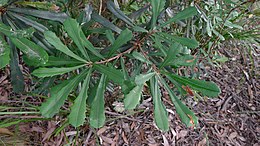
Back نبات صلب الأوراق Arabic Sklerofitlər Azerbaijani Склерафіты Byelorussian Esclerofil·le Catalan Hartlaubvegetation German Sklerofila vegetaĵaro Esperanto Esclerófilo Spanish سختبرگ Persian Sclerofillo Italian 硬葉樹林 Japanese


Sclerophyll is a type of vegetation that is adapted to long periods of dryness and heat. The plants feature hard leaves, short internodes (the distance between leaves along the stem) and leaf orientation which is parallel or oblique to direct sunlight. The word comes from the Greek sklēros (hard) and phyllon (leaf). The term was coined by A.F.W. Schimper in 1898 (translated in 1903), originally as a synonym of xeromorph, but the two words were later differentiated.[1]
Sclerophyllous plants occur in many parts of the world,[2] but are most typical of areas with low rainfall or seasonal droughts, such as Australia, Africa, and western North and South America. They are prominent throughout Australia, parts of Argentina, the Cerrado biogeographic region of Bolivia, Paraguay and Brazil, and in the Mediterranean biomes that cover the Mediterranean Basin, California, Chile, and the Cape Province of South Africa.
In the Mediterranean basin, holm oak, cork oak and olives are typical hardwood trees. In addition, there are several species of pine under the trees in the vegetation zone. The shrub layer contains numerous herbs such as rosemary, thyme and lavender. In relation to the potential natural vegetation, around 2% of the Earth's land surface is covered by sclerophyll woodlands, and a total of 10% of all plant species on Earth live there.
- ^ Bowman, D. M. J. S., ed. (2000). Australian Rainforests: Islands of Green in a Land of Fire. Cambridge: Cambridge University Press. pp. 48–67. doi:10.1017/cbo9780511583490.004. ISBN 978-0-521-46568-7.
- ^ C. Michael Hogan. 2010. Leather Oak, Quercus durata. Encyclopedia of Earth. National Council for Science and Environment. Washington, DC
© MMXXIII Rich X Search. We shall prevail. All rights reserved. Rich X Search